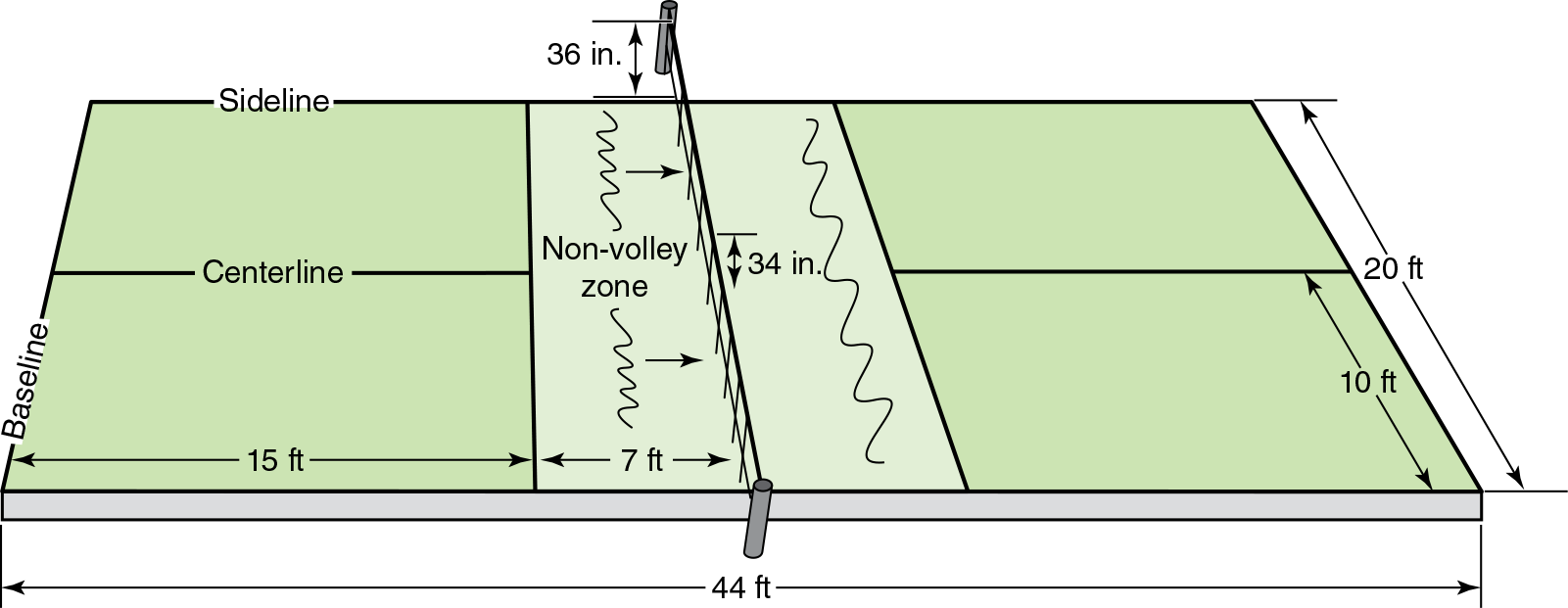Incorporate pickleball into your physical education program
This is an excerpt from Dynamic Physical Education for Secondary School Students-10th Edition by Timothy A Brusseau,Heather Erwin,Paul W Darst,Robert P Pangrazi.
Pickleball is one of the fastest-growing sports in the world. Named after a family dog, the game was invented in 1965. The official court resembles a tennis court but is much smaller (see figure 16.5 for a pickleball court layout). Pickleball is played with a Wiffle ball and paddles, and it has distinctive scoring systems and rules that can be modified for a physical education environment. The most unique rule is the non-volley zone. If a player’s feet are in this space, they cannot hit a ball coming over the net before it bounces. Pickleball is an excellent activity to precede tennis when taught in a manner that ensures success and skill development.

Reprinted by permission from USA Pickleball Association, Pickleball Fundamentals (Champaign, IL: Human Kinetics, 2015), ix.
Sequence of Skills
The following is a breakdown of the skills needed to successfully participate in pickleball.
Grip
Several grips can be used in pickleball. However, the easiest beginner grip is the handshake grip. Students hold the paddle by the face with their nondominant hand and the paddle face perpendicular to the ground. With their dominant hand they shake hands with the handle. Thus, it is essential to practice gripping the paddle.
Ready Position
Pickleball can be fast paced, so getting in a ready stance as quickly as possible after each play is critical. The foundation of this stance is the athletic position with feet shoulder-width apart, knees bent, heels slightly off the ground, and the waist bent forward, ready to move. The paddle is held with the handshake grip a little above the waist, with arms bent in front of the body. Use these cues for this position:
- Lean forward
- Knees bent
- Paddle up
- Ready to move
Serve
Because the serve is one of the easier strokes to learn and is used to start play, this is a great skill to begin teaching pickleball. The server begins in the straddle position with the nondominant leg and arm forward. The ball is in the nondominant hand, held below the waist, and the paddle is held back in the dominant hand. As the weight transfers forward, the ball is dropped and the paddle moves forward, striking the ball below the waist. A legal serve must travel up off the paddle, the ball must be struck below the waist, and the paddle must be lower than the wrist. While serves can be done in several ways, here the focus is on a soft serve that fosters rallies and play. These skills cues can be used when serving:
- Ball at waist level, paddle back
- Drop and swing
- Follow through to the other shoulder
- Ready position
Forehand
This is likely the most common shot, and a similar motion is used for the serve. The player starts with the opposite side to the target and paddle back. As the ball approaches, the weight is transferred to the front leg and the ball is struck slightly in front of the body. In pickleball the swings are typically short with a follow-through to the opposite shoulder at the farthest. The player quickly returns to ready position. Cues for the forehand are as follows:
- Ready position
- Side to target, paddle back
- Paddle to the ball
- Firm wrist
- Follow through to ready position
Backhand
The backhand is typically a difficult shot for students because the motion is unique. Players begin by positioning themselves so the dominant side is closer to the target. The paddle then moves back across the body at shoulder height. The weight transfers to the front leg as the paddle is brought forward to contact the ball just before it reaches the plane of the body. The wrist is firm, and the paddle is perpendicular to the ground as the arm follows through and the player returns to ready position. Similar to the forehand, the backhand is usually a shorter swing because of the pace of the game. Instructional cues for the backhand include the following:
- Ready position
- Dominant side toward target, paddle across body
- Paddle to the ball
- Firm wrist
- Ready position
Dink Pushing
In pickleball, a dink is a short, soft shot that is struck immediately after the ball bounces. This shot is usually intended to land just over the net. From the ready position, the player takes a short step toward the ball or simply transfers weight to the foot nearer the ball. The backswing (if any) is short and comes forward to contact the ball in front of the body just as it bounces off the ground. With a stiff wrist, the ball is struck using a soft, pushing motion. Cues for the dink include the following:
- Move to the ball
- Racket even with body
- Soft push off the bounce
Volley
The volley is like the dink with the exception that the ball does not bounce. This is a quick shot; the player does not wait for a bounce, and there is no backswing. Volleying can be used for a forehand or a backhand and consists of a blocking motion to push the ball over the net. When players become more skilled, they can experiment with the angle of the paddle and the force they push with for the volley as they work to hit away from their opponent. These skill cues can help students learn to volley:
- Ready position
- See the ball
- Block and push the ball
- Ready position
SHOP

Get the latest insights with regular newsletters, plus periodic product information and special insider offers.
JOIN NOW


